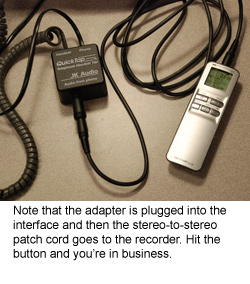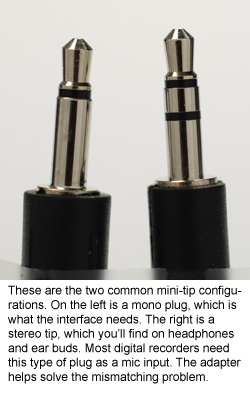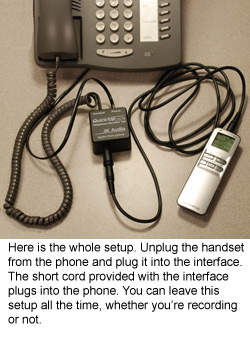Guest column by Peter Welander, Control Engineering process industries editor.
This column is intended to help provide technical advice for editors with the hopes of creating improved audio quality in podcasts, videos, and other online products. Please send your questions.
Since it isn’t always convenient to record a podcast face-to-face, sometimes we have to depend on recording from the phone to get the audio we need to complete a project.
The conventional wisdom is to use one of our conference calling platforms and have it do the recording for us. This works reasonably well assuming you can plan ahead a bit and don’t mind waiting for the company to send you a CD of the recording. (BTW, if you do that, order a .WAV file for best sound quality.) The downside of this is that it does require some planning ahead and everyone on the conversation sounds like they’re on the phone.
(I confess that I have a certain predisposition to technical geekishness, so bear in mind that I may come up with a more complex suggestion than you may want to deal with. I am aware of the problem and do attempt consciously to counteract it. Let me know if I am getting carried away. Whenever possible, I will provide links to where you can buy what I talk about. The two main suppliers will be B&H and Radio Shack because of their universality, but others can work just as well.)
The alternative is to use a small recorder and simply place it near a speaker phone. This may get you intelligible speech, but probably not something with high enough audio quality to use for a podcast.
 There are techniques for recording off the phone that are not all that complicated and can yield decent sound. What you need is a simple device known as a phone interface. One such device that is relatively simple is a QuickTap made by JK Audio. This model sells for $58.95 at B&H. (There are cheaper units available, such as one from Radio Shack. I bought one and the sound was terrible. Don’t waste your time.)
There are techniques for recording off the phone that are not all that complicated and can yield decent sound. What you need is a simple device known as a phone interface. One such device that is relatively simple is a QuickTap made by JK Audio. This model sells for $58.95 at B&H. (There are cheaper units available, such as one from Radio Shack. I bought one and the sound was terrible. Don’t waste your time.)
All you have to do to install this interface is unplug the handset from your phone and put this in between the normal connection. Once in place, you can forget about it and use your phone normally. If you’re not recording, it does not interfere with regular operation. One caution though, it does not work if the keypad is in the handset.
There is a socket on the side of the unit for the audio output. It’s a mini-mono, mic level output. (If you know what that means, you’ll know how to use it. If not, read on.) What you need is a patch cord to plug into your recorder. This is where things can get complicated.
If you’re using a typical small digital recorder, there is probably a jack for an external mic input. Most of these will be “mini” plug size, which is 1/8” in diameter like the headphone jack on your computer and the plug on most lightweight headphones and ear buds. Small recorders are virtually all stereo, so it is probably designed for a stereo microphone. Since the audio from the interface is mono, you simply send the same signal to both sides of the stereo. That’s simple enough, but the patch cords sent with the interface won’t help you.

Here’s why: The photo shows the difference between a mono and stereo plug. They aren’t compatible. Sure, you can plug either into the same socket, but the electrical connections aren’t the same. So to connect the two incompatible sources, you need a patch cord and an adapter. A mini stereo-to-stereo patch cord is very common and used for things like computer speakers, etc. They are easy to find at Radio Shack and other electronics stores. You may even have one lying around. The adapter is less common. You need a stereo female by mono male adapter which is also available from Radio Shack. (My local store had both in stock.) The adapter goes into the interface, and the cord to the recorder.
 Once you’re connected, it will take some experimentation to find the right sound balance. If your recorder has a mic sensitivity adjustment, you will probably need to set it to low, or for use in louder environments. The signal from the interface is relatively strong. You may not have a lot of control over the volume difference between you and your caller. That is one element that may have to be fixed in post production.
Once you’re connected, it will take some experimentation to find the right sound balance. If your recorder has a mic sensitivity adjustment, you will probably need to set it to low, or for use in louder environments. The signal from the interface is relatively strong. You may not have a lot of control over the volume difference between you and your caller. That is one element that may have to be fixed in post production.
So, you ask yourself, “Why shouldn’t I just use the conference recording service? All that sounds like a lot of trouble.” Often that may be an easier answer, certainly. On the other hand, having the ability to record with decent audio quality anytime you want can be very handy. The device can be setup all the time, and when there’s an opportunity, all you have to do is plug in the recorder and go. That can be very helpful when you finally reach that contact you have been stalking, or there is an unexpected opportunity. Sometimes planning ahead isn’t possible, and this helps fill in those gaps.
There are more sophisticated phone interfaces available if you want to try more advanced recording techniques. (That will be a topic for a future discussion.) If you want to see what’s possible, listen to a few minutes of this podcast that was recorded off the phone at my cubicle using a phone interface.